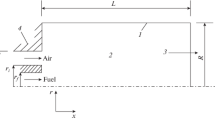Abstract
This study considers numerical simulation of the combustion of methane with air, including oxygen and nitrogen, in a burner and the numerical solution of local entropy generation rate due to high temperature and velocity gradients in the combustion chamber. The effects of equivalence ratio (Φ) and oxygen percentage (γ ) on combustion and entropy generation rates are investigated for different Φ (from 0.5 to 1.0) andγ values (from 10 to 30%). Combustion is simulated for the fuel mass flow rate resulting in the same heat transfer rate (Q)y to the combustion chamber in each case. Numerical calculation of combustion is performed individually for all cases with the use of the Fluent CFD code. Furthermore, a computer program has been developed to calculate the volumetric entropy generation rate and the other thermodynamic parameters numerically by using the results of the calculations performed with the FLUENT code. The predictions show that the increase of Φ (or the decrease of λ) significantly reduces the reaction rate levels. Average temperature in the combustion chamber increases by about 70 and 35% with increase ofγ (from 10 to 30%) and Φ (from 0.5 to 1.0) respectively. With increase ofγ from 10 to 30%, volumetric local entropy generation rate decreases by about 9 and 4% for Φ = 0.5 and 1.0 respectively, while total entropy generation rate decreases exponentially and the merit numbers increase. The ratio of the rates useful energy transfer to irreversibility therefore improves as the oxygen percentage increases
Similar content being viewed by others
References
Abbassi H, Magherbi M, Brahim A B 2003 Entropy generation in Poiseuille—Benard channel flow.Int. J. Thermal Sci. 42: 1081–1088
Barth T J, Jespersen D 1989 The design and application of upwind schemes on unstructured meshes.AIAA 27th Aerospace Sciences Meeting, Reno, (Nevada) Technical Report AIAA-89-0366
Bejan A 1996aEntropy generation minimization (Boca Raton, NY: CRC)
Bejan A 1996b Entropy minimization: the new thermodynamics of finite-size devices and finite-time processes.J. Appl. Phys. 79: 1191–1218
Choudhury D1993 Introduction to the renormalization group method and turbulence modeling.Fluent Inc. Tech. Memo. TM-107
Demirel Y, Kahraman R 1999 Entropy generation in a rectangular packed duct with wall heat flux.Int. J. Heat Mass Transfer 42: 2337–2344
Fluent Inc. 2003FLUENT 6.1 User’s guide. (Lebonon, NH: Fluent Inc.)
Magnussen B F, Hjertager B H 1976 On mathematical models of turbulent combustion with special emphasis on soot formation and combustion. In16th Int. Symposium on Combustion (Philadelphia, PA The Combustion Institute)
Mahmud S, Fraser R A2003The second law analysis in fundamental convective heat transfer problems.Int. J. Thermal Sci. 42: 177–186
Mahmud S, Fraser R A 2002 Thermodynamic analysis of flow and heat transfer inside channel with two parallel plates.Exergy, Int. J. 2: 140–146
Mukherjee P, Biswas G, Nag P K 1987 Second-law analysis of heat transfer in swirling flow through a cylindrical duct.ASME J. Heat Transfer 109: 308–13
Sahin A Z 1998a Second law analysis of laminar viscous flow through a duct subjected to constant wall temperature.ASME J. Heat Transfer 120: 76–83
Sahin A Z 1998b A second law comparison for optimum shape of duct subjected to constant wall temperature and laminar flow.Heat Mass Transfer 33: 425–430
Sahin A Z 1999 Effect of variable viscosity on the entropy generation and pumping power in a laminar fluid flow through a duct subjected to constant heat flux.Heat Mass Transfer 35: 499–506
Sahin A Z 2000 Entropy generation in turbulent liquid flow through a smooth duct subjected to constant wall temperature.Int. J. Heat Mass Transfer. 43: 1469–1478
Sahin A Z 2002 Entropy generation and pumping power in a turbulent fluid flow through a smooth pipe subjected to constant heat flux.Exergy, Int. J.. 2: 314–321
Shuja S Z, Yilbas B S 2001 A laminar swirling jet impingement on to an adiabatic wall. Effect of inlet velocity profiles.Int. J. Numer. Methods Heat Fluid Flow 11: 237–254
Shuja S Z, Yilbas B S, Iqbal M O, Budair M O 2001a Flow through a protruding bluff bodyheat and irreversibility analysis.Exergy, Int. J. 1: 209–215
Shuja S Z, Yilbas B S, Budair M O 2001b Local entropy generation in an impinging jet: minimum entropy concept evaluating various turbulence models.Comput. Methods Appl. Mech. Eng. 190: 3623–3644
Shuja S Z, Yilbas B S, Rashid M 2003 Confined swirling jet impingement onto an adiabatic wall.Int. J. Heat Mass Transfer 46: 2947–2955
Spalding D B 1970 Mixing and chemical reaction in steady confined turbulent flames. In13th Int. Symposium on Combustion (Philadelphia, PA: The Combustion Institute)
Yakhot V, Orszag S A 1986 Renormalization group analysis of turbulence: I. Basic theory.J. Sci. Comput. 1: 1–51
Yilbas B S, Shuja S Z, Budair M O 1999 Second law analysis of a swirling flow in a circular duct with restriction.Int. J. Heat Mass Transfer 42: 4027–4041
Author information
Authors and Affiliations
Corresponding author
Rights and permissions
About this article
Cite this article
Yapici, H., Basturk, G., Kayatas, N. et al. Numerical study of effect of oxygen fraction on local entropy generation in a methane-air burner. Sadhana 29, 641–667 (2004). https://doi.org/10.1007/BF02901478
Received:
Revised:
Issue Date:
DOI: https://doi.org/10.1007/BF02901478



